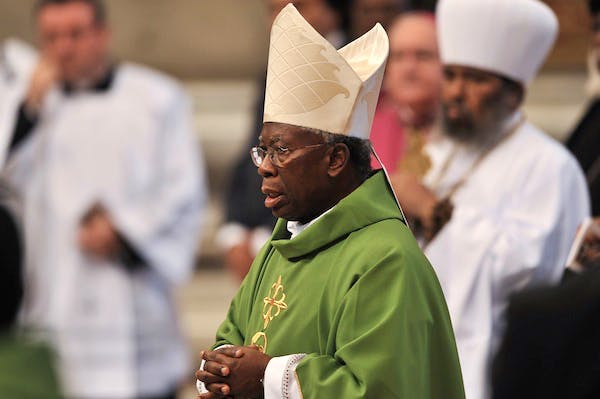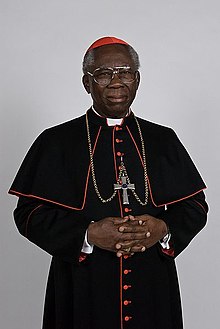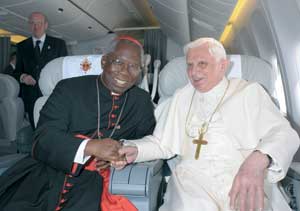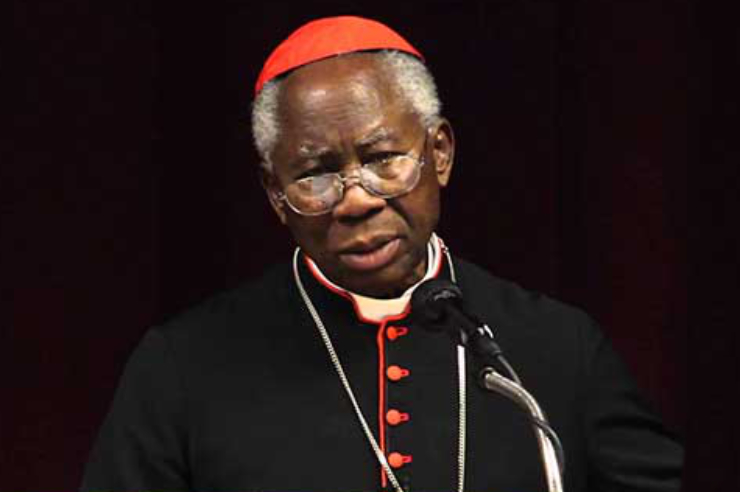 Francis Arinze (born 1 November 1932) is a Nigerian Cardinal of the Roman Catholic Church. He is Prefect Emeritus of the Congregation for Divine Worship and the Discipline of the Sacraments, having served as prefect from 2002 to 2008. He is the current Cardinal Bishop of Velletri-Segni (succeeding Joseph Ratzinger, who became Pope Benedict XVI) since 2005. Arinze was one of the principal advisors to Pope John Paul II, and was considered papabile before the 2005 papal conclave, which elected Benedict XVI.
Francis Arinze (born 1 November 1932) is a Nigerian Cardinal of the Roman Catholic Church. He is Prefect Emeritus of the Congregation for Divine Worship and the Discipline of the Sacraments, having served as prefect from 2002 to 2008. He is the current Cardinal Bishop of Velletri-Segni (succeeding Joseph Ratzinger, who became Pope Benedict XVI) since 2005. Arinze was one of the principal advisors to Pope John Paul II, and was considered papabile before the 2005 papal conclave, which elected Benedict XVI.
Early life
Arinze was born in Eziowelle, Anambra, Nigeria. A convert from an African traditional religion, he was baptized on his ninth birthday (1 November 1941) by Father Michael Tansi, who was beatified by John Paul II in 1998. His parents later converted to Catholicism. At age 15, he entered All Hallows Seminary of Onitsha from which he graduated and earned a philosophy degree in 1950. His father was initially opposed to his entering the seminary, but after seeing how much Francis enjoyed it, he encouraged him. Arinze stayed at All Hallows until 1953 to teach. In 1955, he went to Rome to study theology at the Pontifical Urban University, where he ultimately earned a doctorate in sacred theology summa cum laude. On 23 November 1958, at the chapel of the university, Arinze was ordained to the priesthood by Gregorio Pietro Agagianian, pro-prefect of the Sacred Congregation for the Propagation of the Faith.
 As priest
As priest
After ordination, Father Arinze remained in Rome, earning a master’s in theology in 1959 and doctorate in 1960. His doctoral thesis on “Ibo Sacrifice as an Introduction to the Catechesis of Holy Mass” was the basis for his much used reference work, “Sacrifice in Ibo Religion”, published in 1970. From 1961 to 1962, Arinze was professor of liturgy, logic, and basic philosophy at Bigard Memorial Seminary. From there, he was appointed regional secretary for Catholic education for the eastern part of Nigeria. Eventually, Arinze was transferred to London, where he attended the Institute of Education and graduated in 1964.
Episcopate
Francis Arinze became the youngest Roman Catholic bishop in the world when he was consecrated on 29 August 1965, at the age of 32. He was appointed titular bishop of Fissiana, and named coadjutor to the Archbishop of Onitsha, Nigeria. He attended the final session of the Second Vatican Council in that same year along with the 45-year-old Archbishop of Kraków, Karol Wojtyla, the future Pope John Paul II. Following the death of the Archbishop of Onitsha in February 1967, Arinze was appointed to the position a few months later, on 26 June 1967. He was the first native African to head his diocese, succeeding Archbishop Charles Heerey, an Irish missionary.
 As archbishop
As archbishop
The new Archbishop did not have much time to settle into his office before the Nigeria-Biafra War broke out. The entire archdiocese was located in the secessionist Biafran territory during the Nigerian Civil War. As a result of the war, Archbishop Arinze had to flee his see city of Onitsha and to live as a refugee, first in Adazi and then Amichi, for the three years of the war, which lasted from 1967 to 1970.
Despite his own refugee status, Archbishop Arinze worked tirelessly for refugees, displaced persons, the sick and the hungry, offering support to priests and religious, and giving the faithful hope for the future. With the help of foreign missionaries, he supervised what one international relief worker called one of “the most effective and efficient distributions of relief materials” in history. He also took care to keep the Church separate from the ongoing political conflict, gaining the respect of all factions in the country.
Francis Arinze was still Archbishop of Onitsha when the Nigeria-Biafra war ended in 1970. As a part of Biafra, Onitsha and its people had suffered greatly in the three-year war. The homes and businesses of the people had been devastated, and the already poor region was sinking deeper into poverty. The end of the war did not mean an end to the challenges facing the young Archbishop.
The Nigerian government deported all foreign missionaries stationed in the archdiocese, leaving only the native clergy and religious, who were few in number. The government also confiscated the Catholic schools, most of which also served as churches or parish halls.
Impressed by Arinze’s many accomplishments as the leader of an archdiocese with few resources, and his ability to work side by side with Muslims in a country that is majority Christian (the fearful refusal of Muslims in the north, where they are a local majority, not to allow religion and ethnicity to feature in the recent census in Nigeria is viewed by analysts as an acknowledgement of the Christian numerical superiority in the country as a whole), and with a strong and not-to-be-ignored Muslim population, Pope John Paul II in 1979 appointed Arinze pro-president of the Vatican’s Secretariat for Non-Christians, later renamed the Pontifical Council for Interreligious Dialogue. Archbishop Arinze continued as the ordinary of his archdiocese, and was the unanimous choice of his brother bishops for President of the Nigerian Bishops Conference in 1984.
A year later, the people of Onitsha organized a pilgrimage to Rome when they learned that Archbishop Arinze would be named a Cardinal at the Consistory of 25 May 1985.
Cardinalate
| Styles of Francis Arinze |
|
|---|---|
 |
|
| Reference style | His Eminence |
| Spoken style | Your Eminence |
| Informal style | Cardinal |
| See | Velletri |
On 8 April 1985, Arinze resigned from his post in Onitsha, and the Pope named him a Cardinal-Deacon of San Giovanni della Pigna, little more than a month later in the consistory held on 25 May 1985; he was raised to the rank of cardinal-priest in 1996. Two days following his elevation to cardinal deacon, Arinze was appointed President of the Pontifical Council for Interreligious Dialogue.
In this position, Arinze’s visibility to the world public increased. This post is largely considered to have made Cardinal Francis Arinze’s career. He served in various related capacities including the president of the Special Assembly for Africa of the Synod of Bishops. He also received honours in this capacity: On 24 October 1999 he received a gold medallion from the International Council of Christians and Jews for his outstanding achievements in inter-faith relations. He traveled extensively and became a popular speaker in the United States.
 Cardinal Arinze became even more visible to the public as a member of the Committee of the Great Jubilee of the Year 2000. In that capacity, he worked closely with individual bishops and priests throughout the world in preparation for the rare celebration of the Church. Pope John Paul II was greatly impressed with the leadership of Cardinal Arinze and on 1 October 2002, Arinze was named prefect of the Congregation for Divine Worship and the Discipline of the Sacraments.
Cardinal Arinze became even more visible to the public as a member of the Committee of the Great Jubilee of the Year 2000. In that capacity, he worked closely with individual bishops and priests throughout the world in preparation for the rare celebration of the Church. Pope John Paul II was greatly impressed with the leadership of Cardinal Arinze and on 1 October 2002, Arinze was named prefect of the Congregation for Divine Worship and the Discipline of the Sacraments.
When Pope Saint John Paul II died on 2 April 2005, all major Vatican officials – including Arinze – automatically lost their positions. Arinze was one of the cardinal electors who participated in the 2005 papal conclave that elected Pope Benedict XVI. He returned to his post as prefect of the Congregation for Divine Worship when confirmed by Benedict on 21 April 2005. Four days later, on 25 April 2005, he was advanced to Cardinal Bishop of Velletri-Segni, which had been vacated by the ascension of Cardinal Ratzinger to the papacy.
On 9 December 2008 Benedict accepted the resignation of Arinze as prefect of the Congregation of Divine Worship. His successor, who took office that same day, is Cardinal Antonio Cañizares Llovera. On his eightieth birthday on 1 November 2012 Cardinal Arinze lost his eligibility to participate and vote in any future conclaves occurring as the result of any period of sede vacante.
 Arinze remains active and in 2009 gave the commencement address at the Augustine Institute in Denver. He actively catechises via Familyland TV to the Americas, the Philippines, Africa, and Europe. He has produced over 1,700 television programs with the Apostolate for Family Consecration. The programs cover almost all of Pope John Paul II’s encyclicals and apostolic letters, Vatican II, and many other topics. In July 2009, he delivered a major speech promoting interreligious dialogue at The City Club of Cleveland. He is also the author of several books along with a complete “Consecration and Truth Catechetical Program” for children and adults.
Arinze remains active and in 2009 gave the commencement address at the Augustine Institute in Denver. He actively catechises via Familyland TV to the Americas, the Philippines, Africa, and Europe. He has produced over 1,700 television programs with the Apostolate for Family Consecration. The programs cover almost all of Pope John Paul II’s encyclicals and apostolic letters, Vatican II, and many other topics. In July 2009, he delivered a major speech promoting interreligious dialogue at The City Club of Cleveland. He is also the author of several books along with a complete “Consecration and Truth Catechetical Program” for children and adults.
Publications
- The Family Catechism on Tape, Apostolate for Family Consecration
- Divine Providence: God’s Design in Your Life (2005)
- Building Bridges: Interreligious Dialogue on the Path to World Peace (2004)
- Cardinal Reflections: Active Participation and the Liturgy (2005)
- The Holy Eucharist (Our Sunday Visitor, 2001) ISBN 0-87973-978-9
- The Church in Dialogue: Walking With Other Believers (1990)
- Meeting Other Believers: The Risks and Rewards of Interreligious Dialogue (1998)
- Celebrating the Holy Eucharist (2006)
- Religions for Peace (Darton, Longman & Todd, 2002)
- God’s Invisible Hand: The Life and Work of Francis Cardinal Arinze, Ignatius Press, 2006
- Great Figures in Salvation History: David and Solomon, an interview with Cardinal Arinze and Roy Schoemann, Ignatius Press, 2006








Yea… He is a cardinal with a remarkable achievements. Congrats and may God bless you as take a time off to rest